
The California two-spot octopus, often simply called a "bimac", is an octopus species native to many parts of the Pacific Ocean including the coast of California. One can identify the species by the circular blue eyespots on each side of its head. Bimacs usually live to be about two years old. They are closely related to Verrill's two-spot octopus. In 2015, O. bimaculoides became the first octopus to have a fully sequenced genome.

Gryllus bimaculatus is a species of cricket in the subfamily Gryllinae. Most commonly known as the two-spotted cricket, it has also been called the "African" or "Mediterranean field cricket", although its recorded distribution also includes much of Asia, including China and Indochina through to Borneo. It can be discriminated from other Gryllus species by the two dot-like marks on the base of its wings.
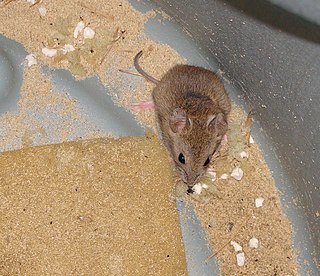
Vesper mice are rodents belonging to the genus Calomys. They are widely distributed in South America. Some species are notable as the vectors of Argentinian hemorrhagic fever and Bolivian hemorrhagic fever.
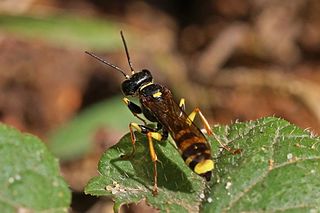
Mellinus arvensis, the field digger wasp, is a species of solitary wasp. The wasp can commonly be found from July to late September or October in sandy places. In hard soil however the female will often try to steal a nest from another member of the same species. The female is larger than the male. The wasps' nests are underground in sandy burrows with flies for their offspring to eat. The species is yellow and black like many wasp species, but they have a more narrow waist. This species is the most dominant immediately following forest fires.
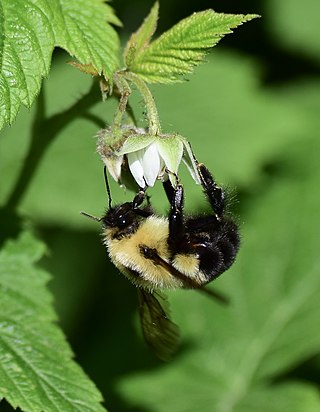
The two-spotted bumble bee is a species of social bumble bee found in the eastern half of the United States and the adjacent south-eastern part of Canada. In older literature this bee is often referred to as Bremus bimaculatus, Bremus being a synonym for Bombus. The bee's common name comes from the two yellow spots on its abdomen. Unlike many of the other species of bee in the genus Bombus,B. bimaculatus is not on the decline, but instead is very stable. They are abundant pollinators that forage at a variety of plants.

Ompok bimaculatus, known as butter catfish, is a species of sheatfishes native to Asian countries such as Bangladesh, India, Pakistan, and Sri Lanka, but recently identified in Myanmar. It also indetified in Mekong Basin of Vietnam
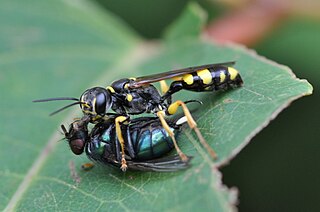
Mellinus is a genus of wasps in the family Mellinidae. The species are found in the Palearctic, Nearctic, the Neotropics and the Orient. 16 species are known
The Moluccan monarch is a species of bird in the family Monarchidae. It is found in Indonesia. Its natural habitats are subtropical or tropical moist lowland forests and subtropical or tropical moist montane forests.
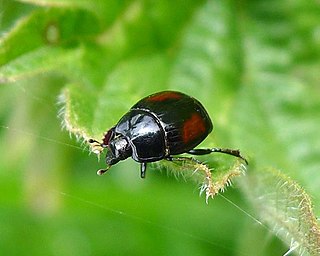
Atholus bimaculatus is a species of clown beetle in the family Histeridae. It is found in Africa, Europe and Northern Asia, North America, South America, and Southern Asia.

Goniocloeus bimaculatus is a species of fungus weevil in the beetle family Anthribidae. It is found in North America.

Lepyrus is a genus of true weevils in the beetle family Curculionidae. There are more than 70 described species in Lepyrus.
Plauditus is a genus of small minnow mayflies in the family Baetidae. There are about 10 described species in Plauditus.
Enoclerus bimaculatus is a species of checkered beetle in the family Cleridae. It is found in North America.

Amphicerus bimaculatus, also known as the grape cane borer beetle, is a species of horned powder-post beetle in the family Bostrichidae. It is found in Africa, Europe and Northern Asia, and North America.
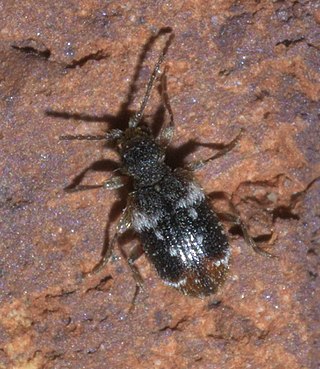
Ptinus bimaculatus is a species of spider beetle in the family Ptinidae. It is found in North America.
Dysdercus bimaculatus, the two-spotted cotton stainer, is a species of red bug in the family Pyrrhocoridae. It is found in North America, and South America.

Sphaeriestes is a genus of narrow-waisted bark beetles in the family Salpingidae. There are about 13 described species in Sphaeriestes.
Mellinus imperialis is a species of wasp in the family Mellinidae. It is found in Central America and North America.

Octopus bimaculatus, commonly referred to as Verrill's two-spot octopus, is a similar species to the California two-spot octopus, which it is often mistaken for. The two can be distinguished by the difference in the blue and black chain-like pattern of the ocelli. O. bimaculatus hunt and feed on a diverse number of benthic organisms that also reside off the coast of Southern California. Once the octopus reaches sexual maturity, it shortly dies after mating, which is approximately 12–18 months after hatching. Embryonic development tends to be rapid due to this short lifespan of these organisms.

The twospot astyanax, also called the two-spot tetra, is a small species of freshwater fish native to South America. It is a middlingly common tetra in the aquarium industry, with hobbyist reports of its sale and presence, and it is also a well-studied member of the genus Astyanax in wild settings. Amateur aquarists report peaceful schooling behavior in captivity, though fish in wild schools may turn on one another if presented with the threat of a predatory species.














